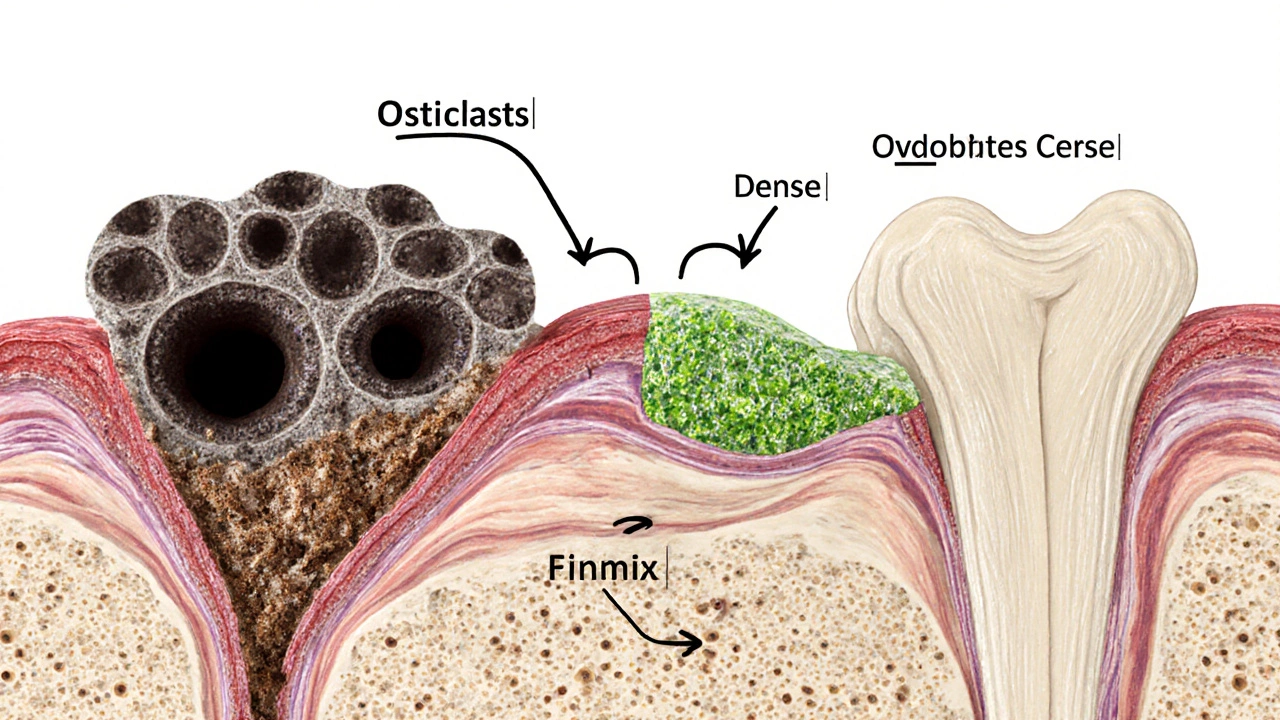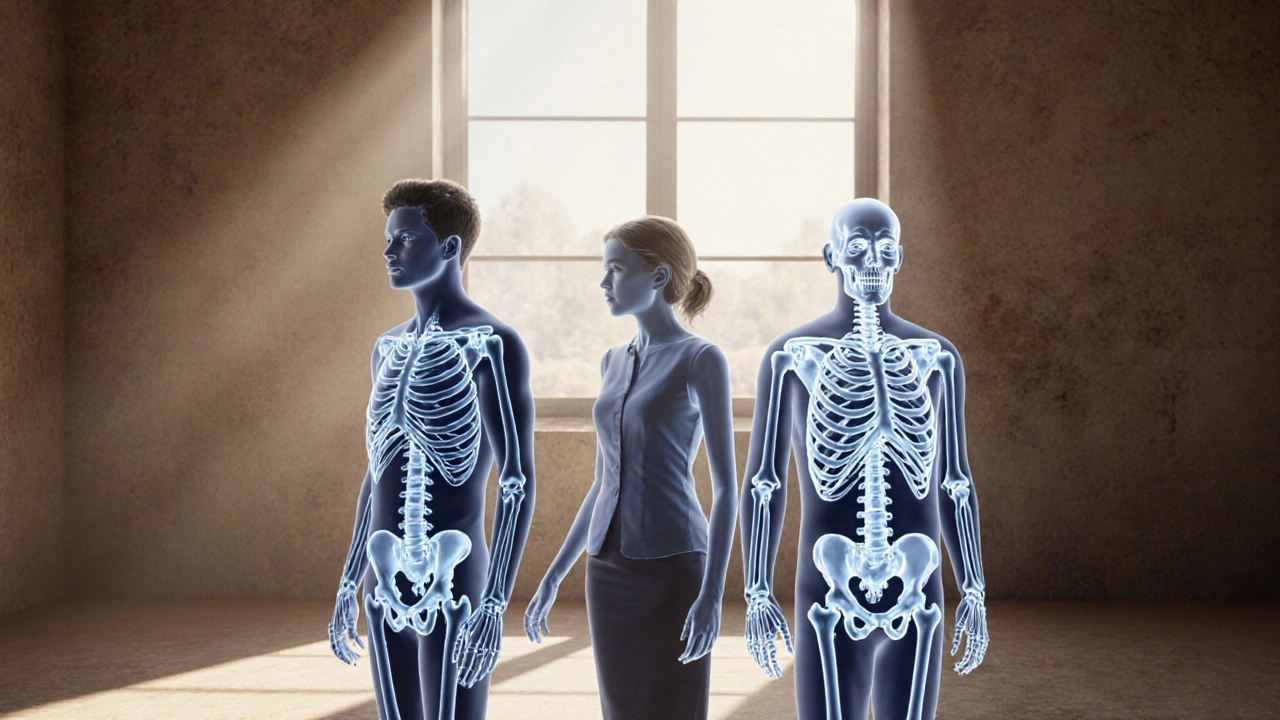Bone Density Risk Calculator
Assess Your Bone Health Risk
Your Bone Health Assessment
Risk Level
Key factors affecting your score:
Recommendations
When people hear the term bone loss is the gradual weakening and thinning of skeletal tissue that can lead to fractures and reduced mobility, they often assume it only affects the elderly. In reality, the process can start much earlier and is influenced by lifestyle, nutrition, and medical factors. This guide walks you through what triggers bone loss, how to spot it early, and practical steps to keep your skeleton strong.

How Bones Stay Healthy: The Remodeling Cycle
Bone isn’t a static structure; it’s constantly being rebuilt in a process called bone remodeling where old bone tissue is broken down by cells called osteoclasts and new bone is formed by osteoblasts. Under normal circumstances, the two phases balance each other, preserving bone density. When the breakdown outpaces formation, bone loss accelerates, leading to weaker bones over time.


Russell Martin
October 12, 2025 AT 13:14Yo, bone loss ain't just for old folks.
Keep moving and load up on dairy, it'll help.
Jenn Zee
October 21, 2025 AT 15:33When we speak of bone health, we must first acknowledge the moral imperative to treat our bodies as temples, not as disposable vessels for fleeting pleasures.
It is a profound neglect to ignore the cascade of biochemical events that leads to osteoclastic dominance, a process that the enlightened should actively resist.
Indeed, the very act of smoking, a habit that burns away not just lungs but also the very scaffolding of our skeletal system, is a betrayal of one's own lineage.
Similarly, excessive alcohol consumption, that insidious libation, sabotages the delicate balance of calcium homeostasis, and any connoisseur of prudence would eschew such excess.
One must also consider the ancient wisdom embedded in the practice of weight‑bearing exercise, a ritual as old as humanity itself, serving to stimulate osteoblast activity and fortify the osseous framework.
Absent this disciplined regimen, we surrender to a fate of fragility, an outcome unworthy of any self‑respecting individual.
The dietary choices we make, particularly the intake of calcium‑rich sustenance, act as the cornerstone upon which robust bones are built, and to neglect this is to invite decay.
Vitamin D, the oft‑overlooked sun‑derived catalyst, operates synergistically with calcium, and its deficiency is a silent architect of bone loss that the careless ignore.
Moreover, the modern medical community, in its hubris, sometimes fails to underscore the importance of early screening, a lapse that permits subclinical osteoporosis to fester unchecked.
One must advocate for bone density testing not merely as a diagnostic tool but as a preventative ceremony, a rite of passage toward longevity.
By confronting these multifaceted contributors-age, gender, lifestyle, nutrition, and activity-we embrace a holistic doctrine of prevention.
In doing so, we uphold a standard of corporeal stewardship that elevates us beyond the myopic concerns of the present moment.
Therefore, let us commit to a regimen that marries mindful consumption with disciplined movement, thereby securing a skeletal legacy for future generations.
don hammond
October 30, 2025 AT 17:36Wow, a bone calculator? Guess we finally turned the internet into a doctor’s office 😂
Still, it’s nice to see an easy way to see if you’re secretly turning into a twig 😜
Steph Hooton
November 8, 2025 AT 19:40I must commend the thoroughness of this guide; it offers a balanced overview of the remodeling cycle.
However, I would like to note a minor oversight regarding the role of phosphorus in bone mineralization, which warrants inclusion for completeness.
Overall, the suggestions are pragmatic and should prove beneficial to many.
Regards,
Justin Channell
November 17, 2025 AT 21:43Bone health is about diet exercise and maybe a little sunlight
Basu Dev
November 26, 2025 AT 23:46Let me elaborate on the interplay between calcium intake and vitamin D synthesis, as it is often misunderstood.
The gastrointestinal absorption of calcium is considerably enhanced when sufficient levels of vitamin D are present, a fact that underscores the necessity of adequate sun exposure or supplementation.
In populations residing at higher latitudes, where sunlight is scarce during winter months, proactive vitamin D supplementation becomes crucial to prevent hypocalcemia and subsequent bone demineralization.
Furthermore, the timing of calcium consumption relative to meals can affect its bioavailability; taking calcium supplements between meals may improve absorption efficiency compared to co‑ingestion with high‑phytate foods.
It is also worth mentioning that certain medications, such as glucocorticoids, can impair calcium balance and accelerate bone loss, necessitating vigilant monitoring in affected individuals.
Lastly, regular weight‑bearing activities like brisk walking, jogging, or resistance training stimulate osteoblastic activity, thereby counteracting the catabolic effects of aging on the skeletal system.
By integrating these nuanced considerations into daily routines, one can substantially mitigate the risk of osteoporosis.
Krysta Howard
December 6, 2025 AT 01:50Stop neglecting your skeleton get a scan now 💪